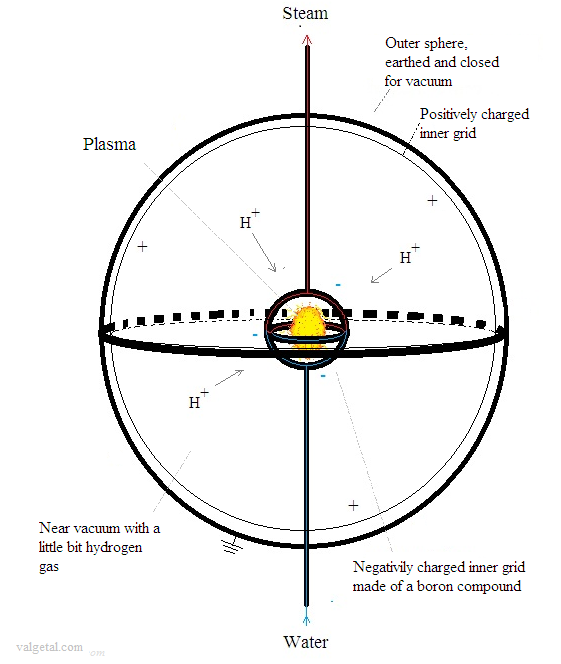 Just some idea's... (not working)
Just some idea's... (not working)5 Breaking the Coulomb barrier by electrostatic acceleration of ions in a device with a grid connected to a extern variable capacitor
 Just some idea's... (not working)
Just some idea's... (not working)
(5e idea)
Fig. 9 Schematic drawing of a fusor with boron compound inner grid.

| With a
Van der Graaff Generator
an high voltage can be achieved. In Van de Graaff Generator Using Cheap Parts
Fig 10. Schematic
representation of a fusor with two grids (represented as
capacitor)
After charging the positive grid of the fusor (approximately a capacitor) and the external capacitor, we disconnect the Van der Graaff Generator. Fig 11. Schematic representation of a fusor with two grids and one parallel capacitor, disconnected from the Van der Graaff Generator and the distance of the plates of the parallel capacitor increased.
After disconnecting the Van der Graaff Generator, the distance of the plates of the external capacitor is increased, for example, 50 times. If this capacitor behaves as an ideal capacitor, the voltage will also increase 50 times, so the total voltage drop over the two grids inside the fusor will become: 50 MV. What hopefully perhaps may occur is that a high speed H+ ion collides with a Boron nucleus in the grid. If it would have a kinetic energy of about 50 MeV, than this should be enough to generate fusion reactions. The boron-hydrogen fusion reaction is one of the nicest ones: 115B + 11H -> 3 42He + 8,68 MeV No noxious neutrons are produces and the 3 negative 42He- particles will move with high speed out of the centre increasing the voltage between the grids. They could perhaps even be used to generate directly electricity. The centre grid could be cooled by water, which hopefully converts into steam by the heat produced by nuclear fusion.
Questions: The schematic representation of fig. 11 could be made in reality? Would there not arise any short circuit (spark) somewhere if we increase the voltage to such high values? How many H+ ions will hit the grid, not causing any fusion but yes wearing the grid? And if we use a mix of H+ ions and boron ions inside the near vacuum chamber?
Also deuterium ions could be used to produce a deuterium fusion reactions (as in a "traditional" fusor). Boron11 hydrogen fusion is not new, see: /49chevy.blogs.com/fusor/2010/01/ufl-breakthrough.html The grid must be heat resistant . Several boron compounds are known for their extreme hardness. Perhaps instead of one capacitor we could use a Marx generator :A number of capacitors are charged in parallel to a given voltage, V, and then connected in series. Remark: If an ion
passes a voltage difference of more then 50.106
V it looses a lot of energy, more then the energy generated by a
possible fusion...
|